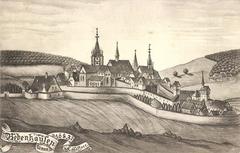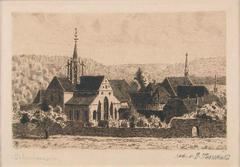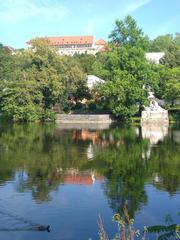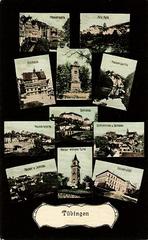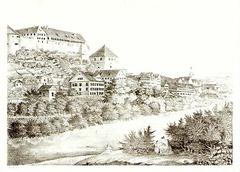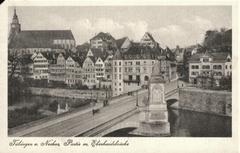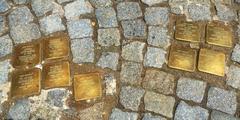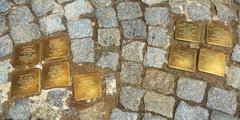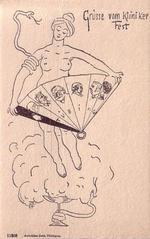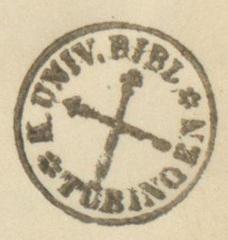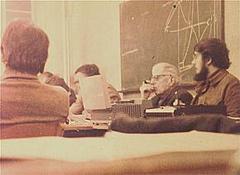
Stadtfriedhof Tübingen: Visiting Hours, Tickets, and Comprehensive Guide to Tübingen’s Historic Cemetery
Date: 04/07/2025
Introduction
Stadtfriedhof Tübingen, located in the heart of Tübingen, Baden-Württemberg, is far more than a cemetery—it is a living archive of the city’s intellectual, artistic, and cultural heritage. Established in the early 19th century during a period of urban transformation, this “Garten des Gedenkens” (garden of remembrance) was designed to provide a tranquil, dignified space for both the deceased and the living. Over nearly two centuries, Stadtfriedhof has become the resting place of renowned poets, academics, civic leaders, and artists, reflecting Tübingen’s enduring status as an academic and cultural center. Its landscaped grounds, artistic gravestones, and proximity to other historical landmarks make it an essential stop for visitors seeking to understand the city’s rich legacy (Tübingen Info; Wikipedia; Kupferblau).
Table of Contents
- Historical Overview
- Architectural & Landscape Features
- Notable Graves and Memorials
- Visitor Information
- Unique Features & Digital Resources
- Practical Tips
- Frequently Asked Questions (FAQ)
- Summary
- References and Further Reading
Historical Overview
Origins and Development
The Stadtfriedhof was established in 1829 as Tübingen’s population grew, following a broader European trend of moving burials from churchyards to landscaped cemeteries outside city walls. This reflected new ideals of hygiene, urban planning, and the Romantic movement’s embrace of nature (Tübingen Info; Wikipedia). The design emphasized curving paths, mature trees, and a park-like atmosphere, creating a space for both remembrance and contemplation.
Throughout the 19th and early 20th centuries, the cemetery expanded to accommodate Tübingen’s growing academic and civic communities. In 1849, Gräberfeld X was established for the Anatomical Institute of the University, a section later memorialized for its role during the Nazi era.
Cultural and Academic Significance
Stadtfriedhof quickly became a “Pantheon” for Tübingen’s scholars, writers, and leading citizens, reinforcing the city’s reputation as a center of learning and culture (touristplaces.guide). Restoration efforts since the late 20th century have preserved its historic character, maintained the integrity of monuments, and promoted its role as a site of education and remembrance.
Architectural & Landscape Features
Layout and Design
The cemetery features:
- Curving, Tree-Lined Paths: Encouraging reflection and exploration.
- Sectioned Plots: Including family graves, academic burials, and special memorial fields.
- Neo-Gothic Chapel (1894): Serves as an architectural focal point and occasional venue for events (City of Tübingen).
Mature linden, oak, and chestnut trees, along with shrubs and seasonal flowers, create a tranquil setting that harmonizes with the city’s urban fabric (Tuebingen.de).
Gravestone Art & Symbolism
Artistic gravestones reflect diverse styles:
- Neoclassical Elements: Columns, urns, and laurel wreaths symbolizing eternity.
- Romantic Motifs: Ivy, roses, and weeping willows signifying mourning and renewal.
- Personal Inscriptions: Many graves of poets and scholars bear verses or quotations (Tübingen Info).
Restoration ensures that these historical and artistic features are preserved for future generations.
Notable Graves and Memorials
Intellectuals & Cultural Figures
Stadtfriedhof Tübingen is the final resting place for countless luminaries:
- Friedrich Hölderlin (1770–1843): Renowned Romantic poet, his grave is a pilgrimage site for literary enthusiasts (famousgravehunter.com).
- Ludwig Uhland (1787–1862): Poet, philologist, and politician.
- Ottilie Wildermuth (1817–1877): Celebrated children’s author.
- Hans Küng: Influential Catholic theologian.
- Walter Jens: Esteemed philologist and writer.
- Friedrich Silcher: Composer and music educator.
- Carlo Schmid: Politician and constitutional scholar (Tuebingen.de; Tuepedia).
Scientists, Physicians, and Academics
More than 170 professors and numerous scientists who contributed to medicine, natural sciences, and humanities are buried here, underscoring the close relationship with Eberhard Karls University (Tuebingen University History).
Civic Leaders and Artists
Graves of former mayors, civic leaders, and artists showcase Tübingen’s social and artistic history.
Memorials of Historical Importance
- Gräberfeld X: Memorializes victims of unethical anatomical research under the Nazi regime. A commemorative plaque and annual remembrance ceremonies foster public awareness (Stadtfriedhof Tuepedia).
- War Graves: Dedicated sections for World War I and II casualties, as well as other memorials for civilian victims, marked by uniform headstones and informative plaques.
Visitor Information
Visiting Hours & Admission
- Hours: Open daily from sunrise until dusk. Typical hours are 8:00 AM to 6:00 PM (April–September), and 8:00 AM to 4:00 PM (October–March). Hours may vary on holidays (Tuebingen.de).
- Admission: Free; no ticket required.
Accessibility
- Paths: Mostly paved and suitable for wheelchairs and strollers; some older sections have uneven surfaces. Comfortable shoes recommended.
- Facilities: Public restrooms near the Gmelinstraße entrance; benches throughout for rest.
Location & Getting There
Situated between Gmelinstraße and Wildermuthstraße, the cemetery is within easy walking distance from the city center, the university, and public transportation. Parking is limited; public transit is recommended (Tuebingen.de).
Guided Tours
- Guided Tours: Available seasonally, focusing on history and notable graves. Advance booking recommended through the Tübingen Tourist Office.
- Self-Guided Tours: Use the “Wo sie ruhen” app for digital navigation and biographies (Tuepedia).
Nearby Attractions
Combine your visit with nearby highlights such as the Hölderlinturm (Hölderlin Tower), Eberhard Karls University, the Neckar riverfront, and Tübingen’s historic old town (touristplaces.guide).
Unique Features & Digital Resources
Special Features
- Neo-Gothic Chapel: Built in 1894, occasionally hosts concerts and events.
- “Was sie schrieben, die hier liegen” Bookshelf: Outdoor open-air bookshelf near the caretaker’s house, featuring works by interred writers.
- Digital Memorials: “Wo sie ruhen” web app helps locate graves and provides biographical info for self-guided exploration (not available for iOS).
Visual and Interactive Media
High-quality images and virtual tours are available on official tourism websites, showcasing the cemetery’s landscape, monuments, and memorials.
Practical Tips
- Respectful Conduct: Maintain quiet and respectful behavior; photography is allowed outdoors but be discreet (The Geographical Cure).
- Navigation: Use digital guides or the “Wo sie ruhen” app for orientation.
- Facilities: Dress appropriately for the weather; carry cash for tours or nearby services.
- Seasonal Notes: The cemetery is particularly peaceful on Sundays and holidays when city shops are closed.
- Accessibility: Contact the visitor office for assistance if you have special needs.
Frequently Asked Questions (FAQ)
Q: Is there an entrance fee for Stadtfriedhof Tübingen?
A: No, admission is free.
Q: What are the visiting hours?
A: Open daily from sunrise to dusk; typically 8:00 AM–6:00 PM (April–September), 8:00 AM–4:00 PM (October–March).
Q: Are guided tours available?
A: Yes, offered seasonally; check the Tübingen Tourist Office for schedules.
Q: Is the cemetery wheelchair accessible?
A: Most main paths are accessible, but some areas may be uneven due to the hillside location.
Q: Can I take photos inside the cemetery?
A: Yes, outdoor photography is permitted; please be considerate of mourners and ongoing ceremonies.
Q: Are there restroom facilities?
A: Yes, near the Gmelinstraße entrance.
Q: How can I find specific graves?
A: Use the “Wo sie ruhen” app or inquire at the visitor information office.
Summary
Stadtfriedhof Tübingen stands as a vital piece of the city’s cultural landscape—a serene, accessible, and historically rich destination. Its harmonious blend of nature, art, and memory invites visitors to walk in the footsteps of poets, scholars, and citizens whose legacies shaped Tübingen and beyond. With free admission, daily opening hours, and a range of resources from guided tours to digital apps, the cemetery is an inclusive space for contemplation, education, and discovery. Enhance your visit by planning ahead, using digital navigation aids, and combining your trip with other Tübingen attractions. Embrace the history and dignity of Stadtfriedhof, and discover the stories that continue to inspire Germany’s academic and cultural heritage (Tübingen Info; Kupferblau; Tuebingen Tourist Office; Tuebingen.de).
References and Further Reading
- Tübingen Info – Stadtfriedhof Tübingen: Visiting Hours, Tickets, and Historical Highlights
- TouristPlaces.guide – Cultural and Intellectual Significance
- Tuepedia – Stadtfriedhof Tübingen Visiting Guide: Historical Graves, Memorials & Visitor Information
- Official Stadtfriedhof Tübingen
- Kupferblau – Visiting Stadtfriedhof Tübingen: Hours, Tours, and Historical Highlights
- Tuebingen.de – Stadtfriedhof
- Wikipedia – Stadtfriedhof Tübingen
- Tuebingen University History
- The Geographical Cure – 20 Key Tips for Traveling in Germany
- Famousgravehunter.com – Top 25 Famous and Infamous Graves to Visit


